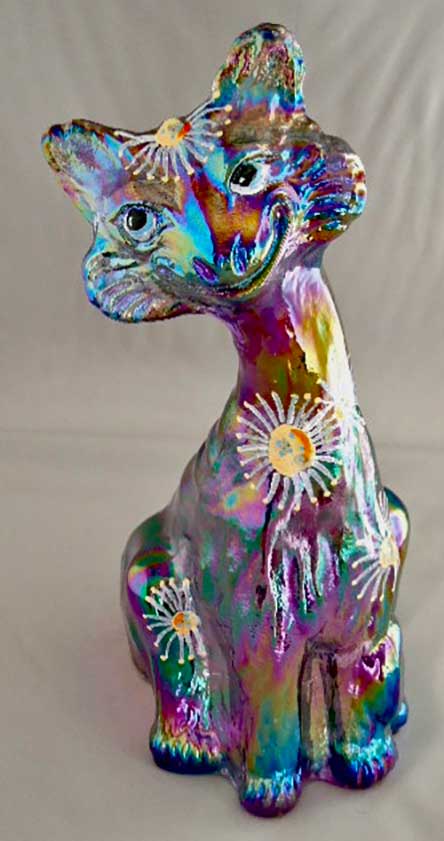September 2023
Good Eye
A Collector’s History with Fenton Art Glass
by Peggy Whiteneck
I’ve been a member of the Fenton Art Glass Collectors of America, founded in 1976, for several years. Unfortunately, I joined not long after Fenton itself ceased making glass in 2011. When the factory was in full swing, it was a big part of many club members’ lives; they got to go on tours and see how the glass was made, to find unusual pieces in the gift shop attached to the factory, and to attend many special sales events held on site. Today, the only way we can purchase much of that special glass is through auctions.
Fenton Art Glass is not some collecting fad, here today and gone tomorrow. On the contrary, there is a resurgence of interest in this glass, including among younger collectors who were just tykes — or even just a spark in their parents’ eyes! — when the factory closed. There’s something for every glass collector in what Fenton made, from the antiques made in the 1910s to the items made right up to the factory’s closing.
In 1990, there was a rift in the Fenton collecting community when the National Fenton Glass Society (NFGS) split off from the Fenton Art Glass Society of America (FAGCA). The majority of members in the two groups are today in a cordial relationship with one another, and many members belong to both clubs. Each holds its own annual convention, and since they occur back-to-back on the calendar, many conventioneers stay to attend both.
Start of a Glass Menagerie
By the time I attended my first FAGCA convention in 2013, the Fenton Gift Shop (now relocated and dealing in Mosser Glass made from Fenton moulds) was still open at the factory and still finding Fenton glass in forgotten storage corners of the huge factory. I bought as much of it as I could afford, and in those final years the gift shop was still open at that factory location, I also purchased several clay models of Fenton animals that never had the chance to go into production.
I started collecting Fenton with the idea of focusing just on the glass “critters,” and even ended up writing a book about them: Fenton Art Glass Beasts, Birds, and Butterflies (currently out of print but due out at a future date in an expanded edition published by the Museum of American Glass in West Virginia). When I began collecting the animals, I could buy most of them in the $25-$35 range. It’s not unusual, though, for the cost to go into three figures, especially for the larger animals such as the Alley Cats (from a mould acquired from US Glass Company in Tiffin, OH) and the Happy Cats and Happy Kitties made as club glass for FAGCA.
When my parents passed, my sisters and I inherited our shares of their vast Fenton collection (Luckily, we all liked different glass treatments!). That’s how I got interested in collecting Fenton Art Glass more generally, everything from vases to baskets and pitchers. I’m sure many readers will be able to relate to this expanded appetite in what they collect!

Fenton Alley Cat
A Fenton Alley Cat I purchased at the FAGCA Convention auction in July. It was made from a U.S. Glass (Tiffin) mould acquired by Fenton when Tiffin closed. This one has a stylized daisy painting on a light Violet glass (To me, the painting looked like exploding fireworks!). It was made late in Fenton’s history, sometime in the 2000s, when, as a cost-saving measure, the company only painted on one side of its items vs. around the entire model. I paid $165 for it, which is about average for Alley Cats these days. In a Randy Clark Auction held the day after convention, another of this same model sold for $210. (Image courtesy of the author)
Today’s Secondary Market in Fenton Art Glass
The interest in Fenton Art Glass seems only to have gotten stronger since the company ceased making it more than a decade ago. The national Fenton clubs also have regional clubs since it is difficult for people living in the western states to attend the annual conventions held on the East Coast. By the time I discovered FAGCA, attendance at the national convention had been very small – about 30-40 people, far from the heyday of gatherings in the hundreds. This summer, the attendance at convention had risen to 110, 40 of whom were brand new members. The interest in Fenton has been further fed by the proliferation of Facebook.
Peggy Whiteneck is a writer, collector, and dealer living in East Randolph, VT. If you would like to suggest a subject that she can address in her column, email her at allwritealready2000@gmail.com.

